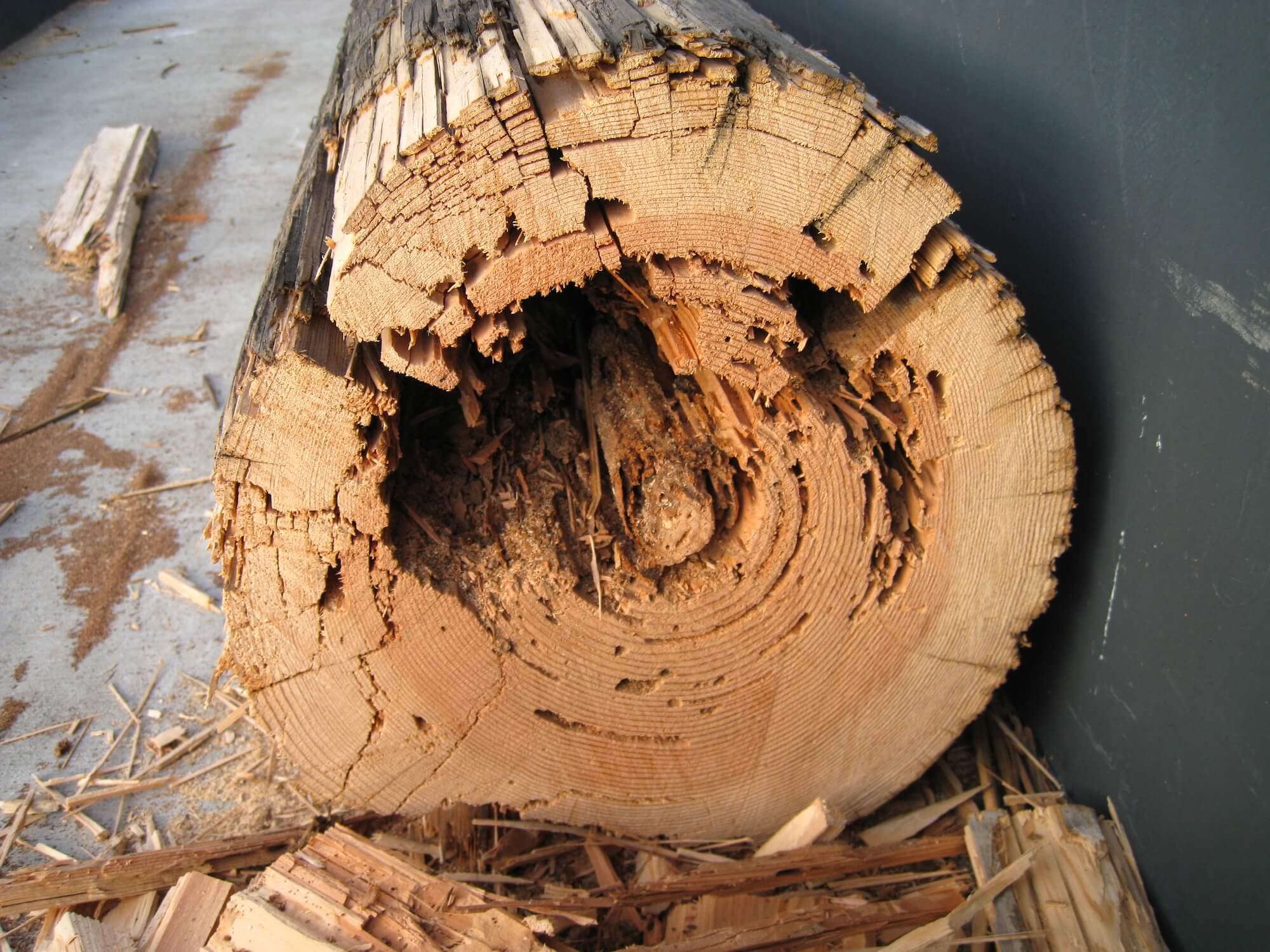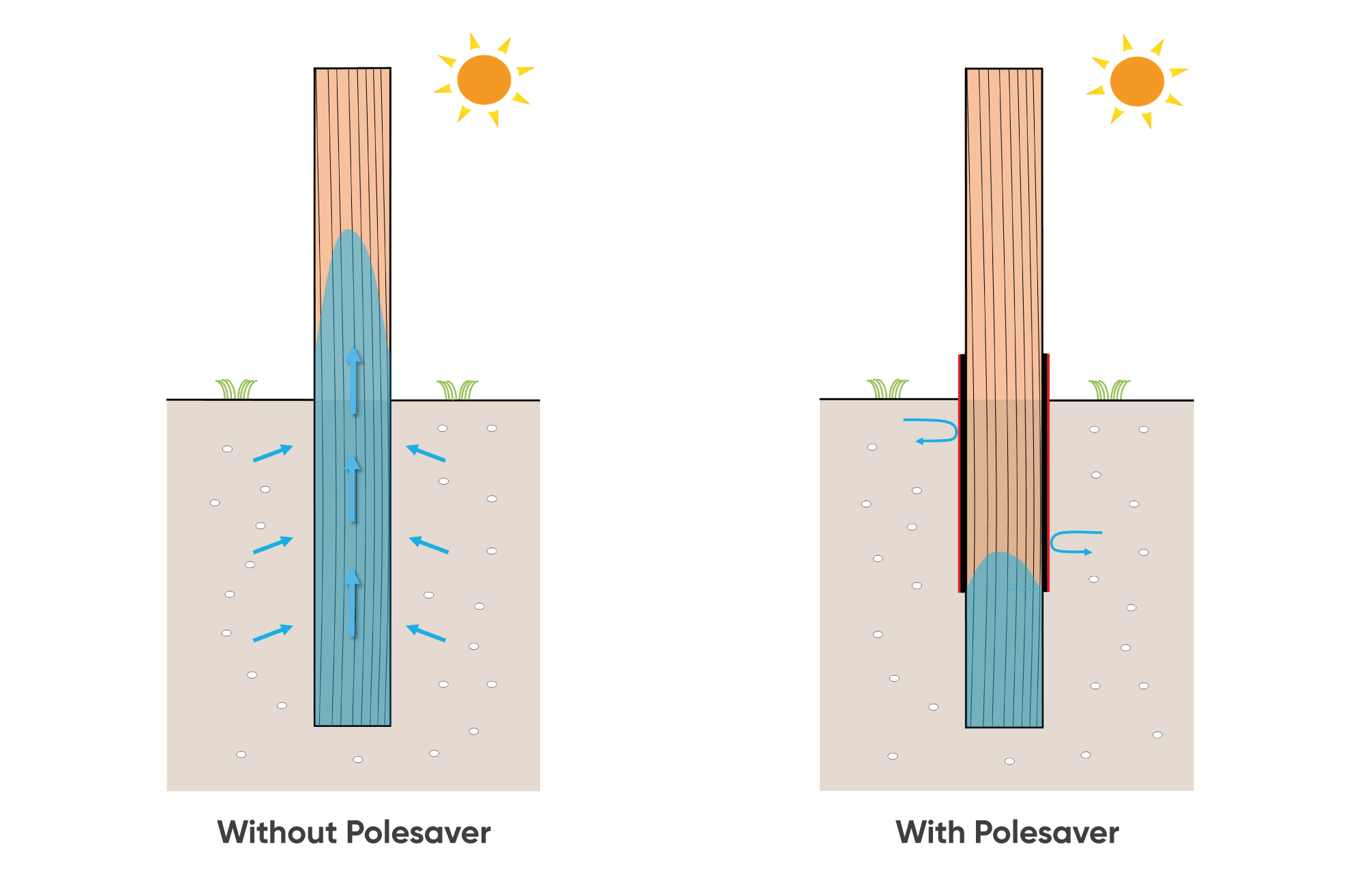Core rot is the decay of the core of a wooden utility pole, occurring at any time during a utility pole’s life.
It usually occurs due to air or insect-borne brown rot fungal spores entering the unprotected core of the pole through cracks in the wood. This process bypasses the preservative protected, outer sapwood shell of the pole.
Moisture from the soil travels up the core from the ground, leading to high moisture content in the core of the pole just above ground level. Combined with the availability of oxygen and warmth, this allows the spores to germinate and attack the un-protected core wood and destroy the core of the pole.
Applying a composite sleeve counteracts this by sealing the surface of the pole and lowering the entry point for moisture. This process “lowers” the “wicking” moisture profile at the ground line section of the pole and typically ensures that the moisture content in the upper part of the sleeve is too low for core rot to occur.
Core or brown rot occurs within the core or central part of the pole, wood preservatives, unfortunately, do not prevent this form of pole decay.
The outer part of a pole is made up of sapwood, the living part of the tree when it was felled. Sapwood is permeable to liquids making it receptive to treatment with wood preservatives. Once the pole has been treated with wood preservative, it protects from soil-borne, soft rot attack.
In contrast, the heartwood is made up of “closed” cells and is relatively impermeable to liquids making it commercially very difficult to treat with wood preservatives. This process leaves the inner core of the pole unprotected from wood decay and rot.
The pole is exposed to natural airflow, weathering and sunlight above ground. Over time this results in drying and shrinkage of the wood, causing the pole to crack and split. These cracks will often run right through into the unprotected core of the pole, as shown in the photograph below.

The majority of wood-decaying organisms are fungi that exist in the upper soil level and attack the fallen organic matter such as wood and leaves. As part of the reproductive process, some of these wood-decaying fungi emit millions of microscopic spores that are carried by the wind. These spores can get blown into the above-ground cracks in utility poles and straight into the unprotected core.
For wood decay to occur a moisture content greater than 25% is necessary. On a standard pole, the moisture content of the core close to ground level will be relatively high and typically well above the 25% threshold at which decay can start to occur (shown in blue in the diagram below).

High moisture content occurs because water enters into and is drawn up the pole from the ground. Known as “wicking”, it happens because of the difference in water vapour pressure between the in-ground and above-ground sections of the pole.
In practical terms, this means that the moisture content of the inner part of the pole 5 to 10 cm above ground level will typically range from 30% to 80% or more. Combined with elevated temperatures, this means that unprotected wood and oxygen create ideal conditions for the brown rot spores to germinate and form wood-decaying fungi that slowly destroy the core of the pole, rendering the pole defective.
Core rot can occur at any time in a utility poles life and is relatively unaffected by the type of wood preservative that is used. It can be a significant cause of failure in poles treated with Creosote, C.C.A. and Pentachlorophenol.
Using Polesaver Sleeves provides a simple but effective means of dramatically reducing the likelihood of core rot.
They achieve this by creating an air and watertight seal on the pole surface. This “lowers” the moisture profile in the pole by 60cm or so as shown in the blue (above). In practice, this means the moisture content in the upper part of the sleeved and above ground section is held at a low level. The moisture level is typically below that at which decaying organisms can thrive thus ensuring that brown rot spores that enter the pole via cracks and splits are unable to germinate and attack the core of the pole.
Learn more about Polesaver Sleeves below.


